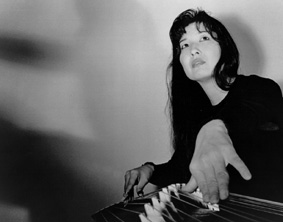| Miya Masaoka is a composer/kotoist performing acoustically and with
the Laser Koto
In her solo performances, she uses her background in Japanese court
music, new music and improvisation to create a span from 9th-century
Japan to sensor and digital technology. With an array of extended techniques
that include strumming, bowing, scratching, and thumps, she uses fragments
of koto-created sounds to weave an organic synthesis of the acoustic
and electronic. Sometimes more acoustic, sometimes moreelectronic, she
developes timbre - based motives, textures and loops.
Using various triggering devices in tandem with live samples, ultra
sound, light sensors and digital signal processing, Masaoka captures
gestures of movement and sound that cross the lines of world music,
jazz, new music, and electronics.
She has collaborated with some of the most noted artists of the twentieth
century, including Ornette Coleman, Toshiko Akiyoshi, Pharoah Sanders,
Reggie Workman, Andrew Cyrille, Steve Coleman, George Lewis, Cecil Taylor
and ROVA Saxophone Quartet.
Her music compositions have led her to varied forms of media and performance.
In "Ritual," giant cockroaches crawl freely on her naked body
breaking laser beams that trigger samples of their own hissing.
Strong imagery, use of the body, technology and a socially engaged impetus
are common threads in her work. A site-specific multi-media piece, "What
is the Difference Between Stripping and Playing the Violin?" was
performed with two erotic dancers and orchestra on Market St. in San
Francisco, with Masoaka composing and conducting.
Masaoka has also colloborated with librettist Thulani Davis to create
the multi-media piece with string quartet, video and Japanese American
interees in "Dark Passages" which premiered at the Asian Art
Museum in San Francisco.
Ms. Masaoka holds a Bachelor of Arts in Music from San Francisco State
University, and a Masters in Music Composition from Mills College. She
has studied with Suenobu Togi, gagaku master who traces his unbroken
line in the Imperial music family for more than 1000 years. She was
Director of the San Francisco Gagaku Society for eight years.
As a composer, she has received commissions from Bang On A Can, Rova
Saxophone Quartet, Meet The Composer and National Endowment for the
Arts and others.
The midi-koto interface was developed over a period of
years and multiple residencies at the institute STEIM in Amsterdam.
The Laser Koto was developed by Donald Swearingen, hardware by Oliver
D'iCicco.
- The koto is a Japanese instrument with moveable
frets in the long zither family of Asian instruments. Its evolution
reflects the continuum of change through the epochs of Japanese history,
and includes ritual, sacred and secualar folk and court forms. The
full name, Kami no koto, means literally, "Oracle of the gods" and
was used in Shinto practices that continues in modern Japan. It is
made of the rather soft kiri wood, and is over six feet long. The
length of the vibrating part of the strings is determined by the placement
of the moveable bridges (ji), each string having one bridge. Different
placement of the ji produce different tunings. There are some 200
scales in Japanese music. The strings are plucked with ivory plectra
(tsume) of varying shape. There are several sizes of modern kotos,
including 13, 17 and 21 stringed kotos.
Selected Discography:
- Saturn's Finger. Trio with Fred Frith, Larry Ochs.
Buzz, 1999.
- "Sliding" Jon Rose and Miya Masaoka, duets. 1998;
Noise Asia
- "The Usual Turmoil and other Duets" Trombonist George
Lewis and Miya Masaoka. 1998 on Music and Arts Programs of America.
- "What is the Difference Between Stripping and Playing
the Violin?" The Masaoka Orchestra. George Lewis, India Cooke, Vijay
Iyer, Trevor Dunn, Hafez Modirzadeh, Francis Wong, Mark Izu, Glen
Horiuchi, Anthony Brown, Elliot Kavee, Liu Qi Chao and others. Masaoka
conducts. 1998 on Victo Records, Canada.
- "Monk's Japanese Folksong" The Miya Masaoka Trio
with Andrew Cyrille and Reggie Workman. 1998 on Dizim Records, Germany.
- "Seance" Henry Kaiser, Miya Masaoka, Danielle DeGruttola.
1996 on VEX Records, Germany.
- "Crepuscular Music" Miya Masaoka, Gino Robair, Tom
Nunn. 1996 Rastascan Records.
- "Compositions/Improvisations" 1993 on Asian Improv
Arts. Debut solo CD with guest flutist James Newton. Miya Masaoka
as a guest:
- Tribute to Tom Cora, 1999 on Avant.
- Duets with World Musicians 1999 Dr. L. Subramaniam
on Erato.
- "Twelve Minor" The Sextet Sessions: Ben Goldberg.
1998 on Avant.
- "Lisle Ellis and Guests" 1996 on Black Saint, Italy.
- "Steve Coleman and the Mystic Rhythm Society" 1996
on BMG/RCA European Division. Recorded live at Hot Brass in Paris
France.
- "Tribute to Sun Ra" 1996 Rastascan Records. Benefit
CD for the Sun Ra Arkestra.
Kunstradioprojekte:
07. 12. 1999: "The
Relative Violin - Wien/Vancouver"
15. 01. 2006: "Chironomy" with Francois Houle and Giorgio Magnanensi (Vancouver) and Klaus Filip and Burkhard Stangl (Wien) LIVE
|

